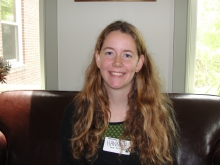You are here
Snapshots from a forest: Comparing 1937, 1992 and 2013
Laying out two tape measures to create a 22.5m x 22.5m square, my first field exercise this summer took place not within the Harvard Forest’s 3,500 acres, but instead on the lawn behind a residential cabin. We were learning to use a compass to place a stake at the NE, NW, SE and SW corners of the square, which is much easier to do in a yard where the only obstacles between you and your partner are inch-long blades of grass and not trees several meters in height. Creating exact plots is necessary for our project because we aim to recreate the plots that were set-up in 1937 and 1992 in the exact same locations. This will enable us to compare our data with the data collected in those years as part of a long-term study in order to see how much carbon is stored in the forest.
Trees take in carbon from the atmosphere, which gets stored in their roots, trunks, branches and leaves. I’m working in a group with four students and five mentors to see how much carbon is being stored. We’re also collecting soil samples, tree cores and data on more specific aspects of plant biology in order to gain a more complete picture of the forest as it changes, which you’ll learn more about in future blog posts.
Not only does the forest provide space for numerous research projects, but it also provides boundless recreational opportunities. The trails are great for running and biking as well as wildlife spotting (we saw a beaver during a stroll along Harvard Pond, newts are abundant along the forest floor and most people are pretty keen to spot a moose) and I’m sure we’ll discover more creative uses for the forest as the summer continues on!
Our group is lucky in that we get to spend loads of time outside. It rained during most of our first week here, but we were able to squeeze in some field work between storms and even when the temperature gets hot, the shade of the forest keeps us much cooler. Finding our plots is an important first step, which means we get to explore large portions of the Harvard Forest, both hiking along the paths and bushwhacking off the trail. We carry our equipment, which includes a GPS unit and other high tech gear such as Dunkin’ Donuts iced coffee straws (for tree cores) to the study sites with us.
Within each plot, we hug each tree to measure its diameter. That information will eventually be translated into the amount of carbon stored using equations specific to different tree species. One of my favorite parts of the project has been learning how to differentiate between hemlock, white pine, striped maple, red oak and the numerous other species we encounter. We also mark down whether each tree is living or dead, which is less obvious than I assumed, but that I expect will become easier as we finish more plots (2 down, at least 98 to go).

Quirky Q&A with Hannah
1. Would you rather see a movie, a parade or a magic show?
Definitely a parade, because they’re outside and you could probably find a magic show within a parade. Plus, the candy is free, unlike at the movie theatre.
2. If you could be a superhero, which special power would you choose to have?
I’d want to be able to speak every language fluently.
3. What is the first word that comes to mind when I say the word “Awesome”?
St. Bernard puppies. Just imagine all of the dogs from Beethoven.
4. What’s your favorite board game?
Monopoly. And even though it’s one of the longest games ever, I used to make “debt cards” so that my friends and I could play even longer.

![[Pat O'Hara measures this tree's DBH, or diameter at breast height.]](/sites/default/files/hannah1_zpsc19b9f71_0.jpg)
